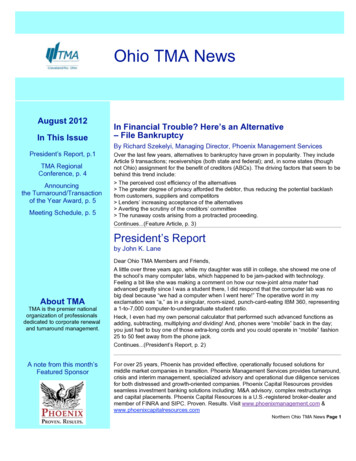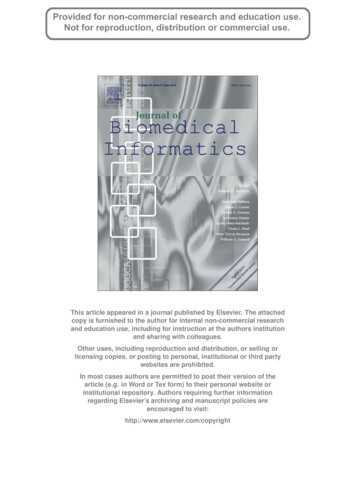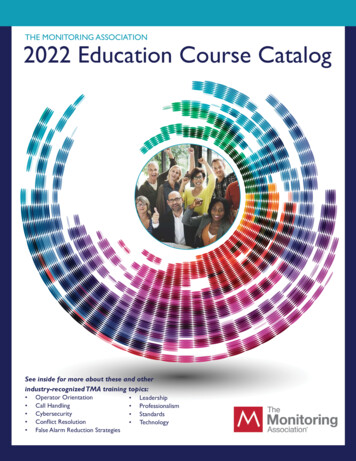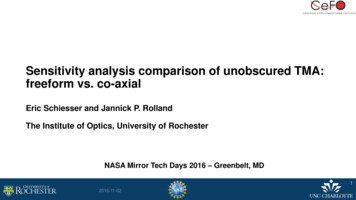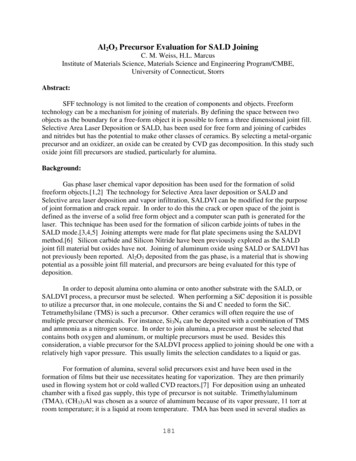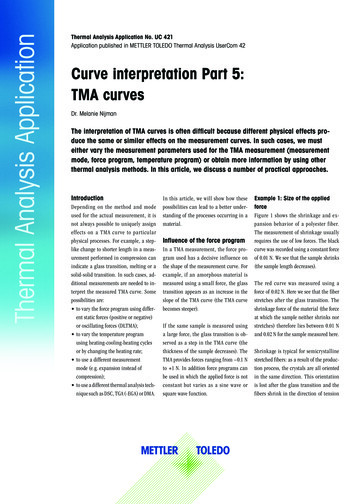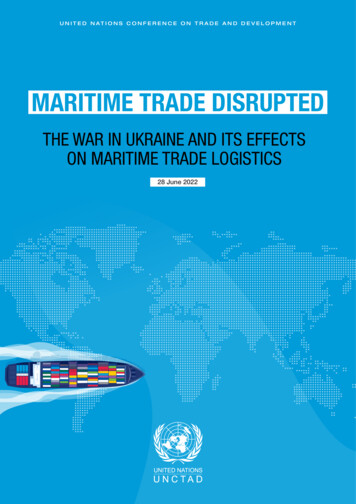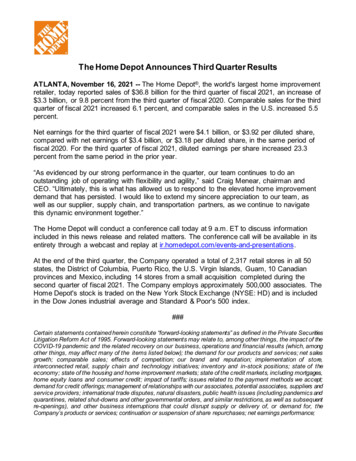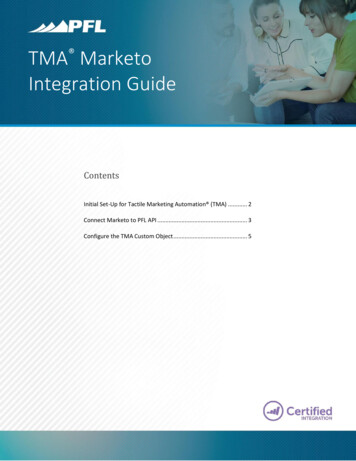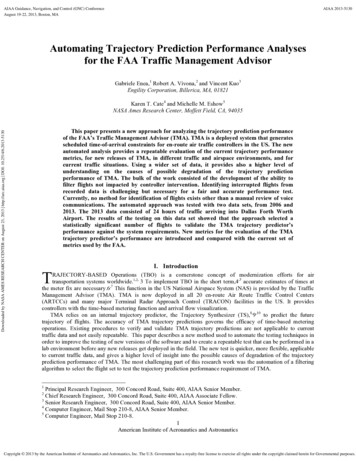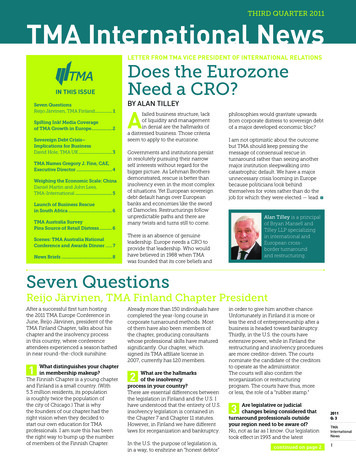
Transcription
THIRD QUARTER 2011TMA International NewsLETTER FROM TMA VICE PRESIDENT OF INTERNATIONAL RELATIONSIN THIS ISSUESeven QuestionsReijo Järvinen, TMA Finland. 1Spilling Ink! Media Coverageof TMA Growth in Europe.2Sovereign Debt Crisis–Implications for BusinessDavid Hole, TMA UK.3TMA Names Gregory J. Fine, CAE,Executive Director.4Weighing the Economic Scale: ChinaDaniel Martin and John Lees,TMA-International. 5Launch of Business Rescuein South Africa.6TMA Australia SurveyPins Source of Retail Distress.6Scenes: TMA Australia NationalConference and Awards Dinner . 7News Briefs.8Does the EurozoneNeed a CRO?BY ALAN TILLEYAfailed business structure, lackof liquidity and managementin denial are the hallmarks ofa distressed business. Those criteriaseem to apply to the eurozone.Governments and institutions persistin resolutely pursuing their narrowself interests without regard for thebigger picture. As Lehman Brothersdemonstrated, rescue is better thaninsolvency even in the most complexof situations. Yet European sovereigndebt default hangs over Europeanbanks and economies like the swordof Damocles. Restructurings followunpredictable paths and there aremany twists and turns still to come.philosophies would gravitate upwardsfrom corporate distress to sovereign debtof a major developed economic bloc?I am not optimistic about the outcomebut TMA should keep pressing themessage of consensual rescue inturnaround rather than seeing anothermajor institution sleepwalking intocatastrophic default. We have a majorunnecessary crisis looming in Europebecause politicians look behindthemselves for votes rather than do thejob for which they were elected — lead.TAlan Tilley is a principalof Bryan Mansell andTilley LLP specializingin international andEuropean crossborder turnaroundand restructuring.There is an absence of genuineleadership. Europe needs a CRO toprovide that leadership. Who wouldhave believed in 1988 when TMAwas founded that its core beliefs andSeven QuestionsReijo Järvinen, TMA Finland Chapter PresidentAfter a successful first turn hostingthe 2011 TMA Europe Conference inJune, Reijo Järvinen, president of theTMA Finland Chapter, talks about hischapter and the insolvency processin this country, where conferenceattendees experienced a season bathedin near round-the-clock sunshine.1What distinguishes your chapterin membership makeup?The Finnish Chapter is a young chapterand Finland is a small country. (With5.3 million residents, its populationis roughly twice the population ofthe city of Chicago.) That is whythe founders of our chapter had theright vision when they decided tostart our own education for TMAprofessionals. I am sure this has beenthe right way to bump up the numberof members of the Finnish Chapter.Already more than 150 individuals havecompleted the year-long course incorporate turnaround methods. Mostof them have also been members ofthe chapter, producing consultantswhose professional skills have maturedsignificantly. Our chapter, whichsigned its TMA affiliate license in2007, currently has 120 members.2What are the hallmarksof the insolvencyprocess in your country?There are essential differences betweenthe legislation in Finland and the U.S. Ihave understood that the entirety of U.S.insolvency legislation is contained inthe Chapter 7 and Chapter 11 statutes.However, in Finland we have differentlaws for reorganization and bankruptcy.In the U.S. the purpose of legislation is,in a way, to enshrine an “honest debtor”in order to give him another chance.Unfortunately in Finland it is more orless the end of entrepreneurship after abusiness is headed toward bankruptcy.Thirdly, in the U.S. the courts haveextensive power, while in Finland therestructuring and insolvency proceduresare more creditor-driven. The courtsnominate the candidate of the creditorsto operate as the administrator.The courts will also confirm thereorganization or restructuringprogram. The courts have thus, moreor less, the role of a “rubber stamp.”3Are legislative or judicialchanges being considered thatturnaround professionals outsideyour region need to be aware of?No, not as far as I know. Our legislationtook effect in 1993 and the latestcontinued on page 22011Q: 3TMAInternationalNews1
continued from page 1changes were made in 2007. Ofcourse, our legislation differs a littlefrom that in other countries.4How did you begin your careerin the turnaround industry?My career in the turnaround industrygot its start when I decided to retirefrom my job as a regional directorin Finnvera, a financial institutionin Finland. Before I retired I decidedto pass the TMA long course, acertification process developed by thechapter. That gave me the possibilityto work with distressed companiesduring my last months in Finnvera.After retiring, I have had the opportunityto continue my career with KrogerusAttorneys as a senior advisor intransactions and financing.5Have you participatedin notable cases?No, I have not. I work mainly as a boardmember for companies and for somereason most of those companies aremore or less distressed. Actually, myjob as the chairman of the board ina Finnish-listed company is mainlyturnaround and restructuring.6Can you recount a favoriterestructuring case? Explainwhy it is your favorite.No, I cannot. Some of the companieswith which I have been involved havesucceeded in turnaround and thathas, of course, given me pleasure.7Do you have a favoritequote or motto thatanchors you as you work?Always hire more skillful peoplethan you are yourself! It has neverbeen difficult for me, indeed. TSpilling Ink!TMA’s Growth inEurope Snags MediaCoverageIn August, Dow Jones Daily BankruptcyReview published “Trouble in EuropeEntices U.S. Corporate-RestructuringExperts,” an article about U.S. law firmsand restructuring advisors expandingbusinesses into Europe because of thedebt crisis roiling the continent and amountain of corporate debt comingdue. Another factor spurring growth isgreater acceptance of the U.S. approachof giving troubled businesses a chanceto rehabilitate. The reporter wrote: “Even the Turnaround ManagementAssociation, a Chicago-based tradeorganization, has seen its ranks growconsiderably in Europe. TMA had 1,006members in Europe at the end of lastyear, up from 310 in 2005. The numberof chapters in the region has doubled. “The growth has come both fromU.S. firms such as AlixPartners andliquidator Gordon Brothers Groupincreasing their ranks in Europeand from Europeans looking toconnect with TMA’s global reach,said TMA President Mark Indelicato. “ ‘Growing in Europe.is a natural nextstep for TMA. As the global economybecomes smaller and smaller, it’s anatural offshoot to see an increasein cross-border transactions.’ “TMA GROWTH IN EUROPEYearReijo Järvinen,TMA FinlandChapter presidentsince May 7201091,006201111988 (midyear)TMA INTERNATIONAL NEWSEditorial Advisory BoardAlan Tilley –TMA Vice President,International RelationsLisa M. Poulin, CTP – TMA ChairpersonMark S. Indelicato – TMA PresidentLinda M. Delgadillo, CAE –TMA Executive DirectorDaniel E. Goldberg – TMA Directorof Integrated CommunicationsMichele Drayton – Managing EditorEditorial CommitteeSandra Abitan – TMA MontrealMichael Fingland – TMA AustraliaJohn Willcock – TMA United KingdomEiten Inamura – TMA JapanColin Batchelor, Jan van der Walt –TMA Southern AfricaTMA MEMBER SURVEY ONINTERNATIONAL BUSINESSIn a September survey of NorthAmerican TMA members, nearly60 percent said they currentlyhave international clients or caseswhile another 20 percent said theyhave had international clients orcases. Responses were split at 6percent each among those who arelooking for international businessengagements and those who are not.Other survey highlights:Top 10 Countries WhereTMA Members ConductInternational Business1. United Kingdom2. China3. Germany4. France5. Japan6. AustraliaIndia*8. Italy9. BrazilNetherlands56%50%45%33%31%27%27%26%25%25%TMA Members withOffices Overseas 28% of TMA members’firms currently have officesoutside of North America 10% have plans to add officesoutside North Americawithin the next year 14% have plans to add officesoutside North Americawithin the next 2-5 yearsTop 10 Countries Outside ofNorth America Where TMAMembers Have Offices1. United Kingdom2. China3. Germany4. France5. Australia6. Japan7. India*8. Italy9. Ireland10. %20%* India and Poland are the only countrieslisted that do not have a TMA chapter.2011Q: 3TMAInternationalNews2
Sovereign Debt Crisis —Implications for BusinessBY DAVID HOLEIread in the press a desire to get back tonormal economic conditions, but fromwhere I stand “what is normal?” I don’tthink we know what normal is anymore.Should normal be pre-2007 whenliquidity was available or pre-2000 or isnormal back to the boom and bust yearsof the 1970s, 1980s and early 1990s? Dowe also take lessons from history? I’mreferring to the period leading to thefinancial crisis of the late 1920s and theconsequences in the 1930s and 1940s.The scale of the current crisis is indeedcomparable but the complexity isfar greater. Will this time round belonger and comparable to the longEuropean depression of 1873 to 1896?Academics blame a sustained periodof living beyond our means due tocredit expansion, and therefore we canexpect a long adjustment. They indicatebetween five and 10 years of lowerstandards of living — all cheerful news.I’m no economic historian but I ama turnaround practitioner. In thisarticle I’m going to set the sceneand comment on the impact forbusiness and where we can assist.In 2007 the subprime bubble in theU.S. broke, leading to the 2008 liquiditycrisis, which led, in turn, to the bankingcrisis at which point there seemed tobe international cooperation to containthe contagion to prevent a repeat of theGreat Depression. Some commentatorsuse the term Great Recession, reluctantto use the “D” word. Various economicstimulus packages across the developedworld gave relief to the liquidity crisis.Since the end of World War II,internationalization and corporateglobalization have flourished withmany international bodies beingformed, most notably free trade areas,the U.N., the International MonetaryFund, the World Bank, the EU andthe list goes on. Sovereign legal andeconomic frameworks were exportedfrom the developed countries toundeveloped countries. The globe isnow a very connected and intertwinedcommunity. Capital, labor andentrepreneurship move relatively freelyat breakneck speed. Many of thesechanges have prevented the worstconsequences of the Great Depression;I refer to trade barriers, protectionism,nationalistic extremes, etc.Didn’t the credit rating agencies havea hand in the build-up to 2008? (Welllet’s not go there for this article.)The economic downturn is in its fifthyear and we are three years from whenLehman Brothers went to the wall; inhindsight, perhaps it was not such asmart move of the U.S. Administrationto allow it to collapse? Confidence inthe banking system is at a low, plus trustand lending between banks are low,again. There is a significant amountof global debt accumulated since thelate 1980s that is maturing and needsto be refinanced in an environmentwhere credit risk and appraisal havestructurally gone back 20 or 30 years.It’s fairly basic stuff, but whether you area consumer, corporate or government,credit worthiness is assessed onyour assets, liabilities, income andexpenditures, and historical recordof keeping to the terms of creditagreements. It’s a downward spiral ifyou need to refinance and no one trustsyou. If they do lend to you, then theinterest rate contributes to the downwardspiral. To take a case in hand, the interestyield for German 10-year bonds is 1.74%and that for Greek debt is 19.54%. Thetwo sovereign states are extremes interms of financial probity but thoseyields reflect what the market thinks.Greece will default, but how and whenit happens are key questions. We want aslow predictable car crash with sufficientfinancial muscle to offset it. (As I writethis article a 3 trillion euro package isplanned to head off the consequences.)Refinancing is and will prove difficultfor those who need to secure it, which isbasically everyone: banks, governments,corporates and consumers. The party isover, the music has stopped, and therearen’t enough chairs for everyone; somewill fail and default. The music will onlystart again when confidence returns,when consumers start to spend again,when consumers are confident to takeon new debt, and when consumers feelsecure once more. It is a virtuous circle.We are now entering the next phaseinvolving the financial creditworthinessof sovereign nations. Subsequentcredit rating downgrades fan the firesof uncertainty. In my opinion, thisphase is the most dangerous. Why? Iuse the analogy of the foundation for abuilding. If the foundation is inherentlyunsound or becomes unsoundthrough events, until you’ve dealt withthe foundation issue, then whateveryou do to the building that stands onthat foundation will amount only topapering and painting over cracksall the time. And that is a very costlyprocess in terms of time and money.We live at a time when free marketeconomics dominate how resourcesare allocated and as a consequence,we need debt and credit to function.However, those functions are assessedby the trust of the borrower to thelender that the borrower can serviceand pay back the principal. Thattrust is reflected in the interest ratecharged. The process is assisted by our“friends,” the credit rating agencies.What the market thinks is incrediblyimportant because what it tells us isthat “perception in the marketplace isthe reality” regardless of facts often. In1933, President Franklin D. Rooseveltsaid, “the only thing we have to fear isfear itself.” In this time, however badthe situation gets, it is made worse byfear and by a loss of consumer, businessand market confidence. Confidenceis the number one priority to address.Some of our friends at the credit ratingagencies and the comments fromsovereign representatives are not alwayshelpful. This is a communication skill, askill that turnaround practitioners havedeveloped and implemented in manystressed situations. It is not constructivefor a leader or the press to overstate ascenario to attract press coverage orsales. It is not rocket science that difficultdecisions have to be made, anotherskill turnaround practitioners possess.In 1933 a London conference on theglobal depression of the time resulted inbickering and dithering without decisiveaction. Given the current sovereign debtcrisis, specifically in Europe — and it isnot alone — I do not see an internationalcontinued on page 42011Q: 3TMAInternationalNews3
continued from page 3leader emerging despite all theinternational organizations. I see muchcommentary but no individual leadingthe charge. I see individual countries,trade areas and monetary unionscoming up with unique solutions, butbecause of the interconnectivity of debtacross borders, these individual solutionsmay not deliver what is needed. This isan international management exerciseand managing stakeholders is anotherskill turnaround practitioners use everytime they begin an assignment.Where will this bold and innovativeleader come from? Will it be PresidentBarack Obama, French PresidentNicolas Sarkozy, German ChancellorAngela Merkel, British Prime MinisterDavid Cameron, the IMF or the WorldBank? I don’t see him or her yet.Regarding business, we have all seenwell-known retail brands becomeinsolvent because consumers aren’tspending and refinancing historicalcorporate debt is proving too difficult.In a sovereign debt crisis scenariogovernments have a variety of options,including Keynesian and monetaristsolutions, currency depreciations,joining monetary unions, quantitativeeasing and austerity measures. Thekey is to avoid deflation, which isregarded as worse than inflation.There is a suggestion in the marketsthat central banks have an agendato stoke inflationary pressure (in theU.K. it is now 4.53%; in U.S., 3.77%; andEuro zone, 2.53%). Why? Debt getsdevalued in real terms by inflation andthe price will be paid for by creditorsand savers. Will those same centralbankers who will also be printingmoney be able to reverse it whenthey need to? Over the last 800 yearswhen banking crises have threateneda sovereign crisis, those cycles havebeen followed by high inflation, mostoften through the control of currency.Historians appear calmer and moresanguine about the sovereign debtcrisis rather than politicians. They see itsimply as effective crisis managementfollowed by a restructure, actions quitefamiliar to turnaround practitioners.Business has become more complicatedand is challenged on all fronts fromturnover forecasts, to pricing, to taxation,to employment skills, to public sector, toprivate sector. No business is immune.In the U.K. we have a benign economicenvironment. Interest rates are at a 300year low, the taxation authorities arebalancing employment against chasingbusinesses funded by non-payment oftaxes, and the banks serve themselvesin terms of overt credit screening andmeeting new capital requirements viaBasel III and sovereign demands. In theU.K. a rather anti-intuitive scenario isarising. There has been less insolvencythan we would expect in such aneconomic down cycle — which meansmore businesses are piling on top ofeach other and sitting precariouslywaiting for an initiator to tip the business.Businesses should not delay. Theyshould realign themselves to the neweconomic environment by ruthlesslyrestructuring balance sheets andprofit-and-loss statements to surviveand prosper and to be sustainable. Inmy own opinion the mid-corporateand global organizations are in betterposition to coordinate cash and changemanagement. The small and midsize enterprises and owner-managedbusinesses are more vulnerableand have fewer resources; in theU.K., small and mid-size companiesaccount for over 90% of businesses.The new buzz phrase is improvingsustainability, a skill imbedded in theDNA of turnaround practitioners.Whatever plan is agreed to by the G-7or G-20 countries, at the very least itneeds to address the debt crisis andissues unique to the eurozone andperhaps even consider proposals foran alternative reserve currency.I conclude with three points:1. The sovereign debt crisis requiresan international solution withbold and innovative leadership.2. Businesses should take thetime now to restructure,regroup and reposition.3. Businesses should useexperienced turnaroundpractitioners to guide them. TDavid Hole, U.K., jointmanaging directorfor Galen Partners inthe UK, and TMA UKChapter director foreducation, welcomesyour comments.E-mail davidhole@galenpartners.co.ukor phone him at 44(0)7976 758 246.TMA Names Gregory J. Fine, CAE,Executive DirectorGregory J. Finejoins TMA onDecember 5,bringing more than15 years of experienceleading and growingassociations. Hecurrently servesas vice presidentof marketing andcommunications for the Association forCorporate Growth (ACG) where he ledthe creation of a strategic marketing andcommunications department, directedthe launch of ACG’s public policy effort,and played a key role in enhancing therelationship between the organizationand its 56 worldwide chapters.Prior to his role with ACG, Fine servedas the director of communications& marketing and executive editor ofFORUM magazine for the AssociationForum of Chicagoland. A recognizedleader in the association community,Fine currently serves on the board,as president, of Association Mediaand Publishing and is an activemember of the Association Forum ofChicagoland and the American Societyof Association Executives (ASAE).“We are excited to introduce Greg as thenext leader of TMA,” says Mark S.Indelicato, TMA president and managingpartner of Hahn & Hessen LLP inNew York. “With his combination ofassociation experience, industryknowledge, and leadership capabilities,we look forward to Greg guiding theorganization to continued growthand success for years to come.”“I am honored to be selected by TMAas the next executive director,” saysFine. “I look forward to working withTMA’s volunteers, chapter leaders andstaff to continue delivering value tothe membership and supporting thecritical role the TMA membershipplays in the global economy.”Fine replaces Linda M. Delgadillo, CAE,who is retiring at the end of 2011following 11 years as TMA executivedirector.2011Q: 3TMAInternationalNews4
Weighing the Economic ScaleChina: Uncertainty Looms over Non-performing LoansBY DANIEL MARTIN AND JOHN LEESAs China emerges from theshadow of an unprecedented 586 billion economic stimuluspackage, which was announced inNovember 2008, we look at the currentbusiness climate and some of the keyeconomic factors affecting China todayand its march toward the numberone spot in the world economy.Fueled by a very strong expansion ofcredit and a broad stimulus package,China has seen constant economicgrowth in excess of 9 percent in 2009and 2010. In a time when European andWestern nations have been weatheringthe storm of post-global financialcrisis “depression” — another debtcrisis potentially looms for Europeannations — what now for China?In view of the increasing property bubblerisks and the rise of non-performingloans, China’s central bank has tightenedeconomic policy by raising interest ratesand the bank’s reserve requirement ratio.Chinese non-performing loansThe debt burden of local governmentshas increased significantly in the wakeof the stimulus plan. Local governmentauthorities are barred from taking ondebt in their own names, so Chinesebanks have provided funding insteadto provincial funding vehicles –intermediary agencies with opaqueoperations to pay for infrastructureprojects such as highways and bridges.City, district and provincial governmentshave rushed to set up funding vehiclesto circumvent the rules. China’snational audit office recently estimatedthe debt held by authorities at 10.7trillion yuan ( 1.67 trillion) at the end of2010, or approximately 27 percent ofChina’s 2010 gross domestic product.The financial information provided bymany of these funding vehicles is veryopaque and some of the projects rushedout were of questionable economicvalue. In other words, analysts nowestimate that anywhere between 2.5trillion to 6 trillion yuan ( 387 billion- 928 billion) in local governmentdebt will not be repaid. Faced with thegrowing risk of nonperforming loans,banks have resorted to securitization.A recent news article titled “AuditorsPoint to Widespread Insolvency inLiaoning Provincial Gov’t Assets”1highlighted serious concernsover provincial governmentfinancing platforms. Some keyfacts from this article include: Government auditors found thataround 85 percent of Liaoning’sprovincial government financingplatform companies defaulted ondebt service prepayments in 2010. The audit office said 120 companieshad operating losses and nearlyhalf of all companies hadserious cash flow shortages. Local government platformcompanies had engaged infraudulent practices to secure anduse loans. Auditors found thatmisappropriated funds totaled 17.6billion yuan from bank loans.To limit the credit expansion, theChinese central bank has tightenedcontrols on bank lending by raisingthe reserve-requirement ratio andreinstated quantitative controls inlending, which have reduced theamount of funds available for loans.This has affected China’s small- andmedium-enterprise (SME) market,which has seen liquidity dry up.Inflation and interest ratesChina’s inflation rose to a three-yearhigh in July 2011, adding pressure onthe Chinese government to reduceand closely monitor living costs whilekeeping economic growth on track asthe outlook for U.S. and Europe worsen.Consumer prices in the world’s secondlargest economy rose 6.5 percent over ayear earlier, up from June’s 6.4 percent,primarily due to surging food costs. TheChinese government has respondedto the sharp price increases by raisinginterest rates for the fifth time in ninemonths in July 2011 to slow economicgrowth. The Chinese central bankannounced that it was raising the keylending and deposit rates by a quarter ofa percentage point: the one-year depositrate would rise to 3.5 percent and theone-year lending rate, to 6.56 percent.Regulating the securities marketsLocal and foreign investors havelost money on companies that havecircumvented regulations on fundraisingwhile surrounding themselves ingovernment authority. There have alsobeen numerous cases of reported fraudwithin these Chinese entities. Thereare over 400 Chinese businesses thathave gained stock market listing in theU.S. by buying public shell companies.This process of acquiring a public shellcompany is known as a reverse mergerand is popular as it avoids the scrutiny ofan initial public offering. The BloombergChinese Reverse Merger Index, whichtracks these firms, is down more than 40percent in June 2011 since November2010 due to the numerous cases ofreported fraud and lack of oversight.The challengesThe risk of defaults on non-performinggovernment loans remains high,although this is likely to be avoidedthrough the intervention of the centralgovernment. Vulnerable or weakcompanies in China that have benefitedfrom the stimulus plan during thecrisis may struggle to survive oncegovernment support is withdrawn.Companies that operate in lowvalue sectors, such as textile, toysand shoes, are especially vulnerabledue to rising salary and wage costs.The appreciation of the yuan ismaking exports more expensive andcompetition from the emergenceof other Asian low-cost producers,such as Bangladesh, Cambodia andVietnam, is putting pressure ontraditional Chinese manufacturers.Therefore, the challenge for thesebusinesses is to transform into viablebusiness entities through a restructuringprocess. If they do not, some of thesebusinesses face certain bankruptcy, asthe Chinese government will be temptedto showcase a few isolated cases. T1CaixinOnline, September 9, 2011John Lees is directorand Daniel Martin is amanager with John LeesAssociates, a specialistaccounting firm offeringa wide spectrumof transactional,turnaround, forensicand corporate recoveryservices in the greaterAsian region, withoffices in Beijing,Hong Kong, Macaoand Shenzhen.2011Q: 3TMAInternationalNews5
Launch of Business Rescue inSouth AfricaOn May 1, Chapter Six of theNew Companies Act launchedbusiness rescue in South Africa,which contains ground breakinglegislation that has considerableimplications for distressed companies.The TMA Southern Africa Chapter(TMA-SA) covered those implicationsin a program organized withthe Companies and IntellectualProperty Commission (CIPC).The first part of the presentation featuredAmanda Lotheringen, head of businessrescue at the CIPC, who discussed: Status of accreditation ofprofessions and licensing ofbusiness rescue practitioners How to file for business rescue How to register as a businessrescue practitioner.Audience members also participatedin the discussion that covered: Actions to take after appointment How different stakeholdersreact to business rescue Negotiations Dealing with uninformedcreditor attorneys Sureties versus guarantees Actions to take during the first 10 days How to handle the firstmeeting of creditors andemployee representatives How to prove claims – form,issue of no interest How to prepare thebusiness rescue plan The meeting to determinefuture of the company. TTMA-SA directors Jan van der Walt andAlastair Macduff later posed questionsto each other about their respectiveexperiences and challenges encounteredin business rescue appointments.Afterward, they invited their clients toshare experiences that triggered theirdecision to undergo a business rescue.5 Amanda Lotheringen, head ofbusiness rescue at the Companiesand Intellectual Property Commission(CIPC), discusses basic steps infiling for business rescue.3 Attendees listen as speakers discussnew business rescue legislationduring a TMA Southern Africa Chaptereducation program in September.TMA Australia Survey Pins Sourceof Retail DistressRetailers are more likely to close stores to address problems causedby too much debt, according to a TMA Australia Chapter surveyconducted with the turnaround advisory firm 333 Consulting.Respondents included professional advisors, executivemanagement, board members, debt holders, and equity holdersinvolved with troubled businesses. Findings include: “Unsustainable debt levels” and “inadequate financialcontrol” replaced subpar management as top causes ofbusiness distress in 2011 compared to the previous year. More than 75 percent of those surveyed believe the retail andmanufacturing sectors will decline in the 2012 fiscal year. 59 percent of turnarounds addressed at least one significantinitiative from each of the four major categories of solutions– balance sheet, pricing and revenue, working capitaland operations/costs – indicating businesses continueto take a holistic approach toward fixing problems. Retailers have increased their use of cost-cutting measures, such asclosing sites and business units, and exiting products or markets. Consumer confidence is at an all-time low, a factor likelyto keep the pressure on retailers and their landlords.This is the second year the chapter has surveyed membersabout industry trends. View the full survey analysis onthe TMA Australia Web site turnaround.org.au/ T2011Q: 3TMAInternationalNews6
ScenesTMA Australia National Conference and Awards DinnerThe 2011 TMA Australia NationalConference and Awards Dinner,August 31-September 2, was a stellarevent blending topflight industryeducation and celebration of the workTMA members perf
to work with distressed companies during my last months in Finnvera. . "Even the Turnaround Management Association, a Chicago-based trade organization, has seen its ranks grow considerably in Europe. TMA had 1,006 . the banking system is at a low, plus trust and lending between banks are low, again. There is a significant amount
